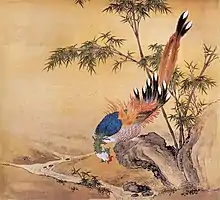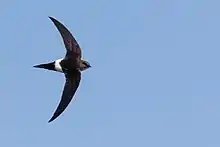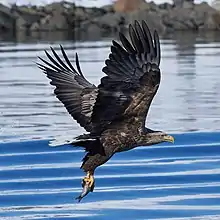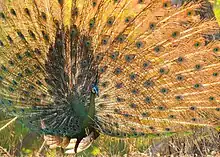| Sae Taryeong | |
| Hangul | 새타령 |
|---|---|
| Hanja | 새打令 |
| Revised Romanization | Saetaryeong |
| McCune–Reischauer | Saet'aryŏng |
| IPA | sɛː.tʰaː.ɾjŋ |
"Sae Taryeong" (Korean: 새타령; Hanja: 새打令; lit. Bird song; IPA pronunciation: [sɛː.tʰaː.ɾjŋ]) is a representative folk song (minyo) of the Jeolla-namdo region of Korea,[1] that describes the sounds and physical descriptions of a variety of birds. The song uses onomatopoeia to describe bird calls from the parrot to the crane. The song was composed by Kim Sam-jin (Korean: 김삼진; Hanja: 金三鎭; MR: Kim Samchin),[2] and the song first attained popularity after it was published in the pansori repertory Jeokbyeokga by Yi Dong-baek (Korean: 이동백).[3] The song follows the Jungjungmori Jangdan beat (Korean: 중중모리 장단),[4] which is also used in pansori and sanjo.[5] The melodic pattern that the song follows is yukjabaegitori,[5] which is a collection of four pitches with gestures (sikimsae), which consists of a vibrating note (tteoneunum), a note with no vibrato (cheong), appoggiatura (kkeokneunnum), and a note that goes upward in pitch while vibrating (eotcheong).[3] An alternate hanja name for the song is "Bijoga" (Korean: 비조가; Hanja: 飛鳥歌).
History
"Saetaryeong" originated in the Jeolla-do region of Korea. The song first attained popularity after it was published in the pansori repertory Jeokbyeokga. It is suggested that it has been sung since the late Joseon period. Singers such as Lee Seok-sun (reign of Heonjong), Il-chi (reign of Cheoljong), Park Yu-jeon (reign of Cheoljong), and Yi Dong-baek (Japanese occupation) were said to have been good at performing the song.[2]
Composition
The song is divided into two parts. The first part is about the scene of spring when swallows fly, and the second about the appearance and sounds of birds. The first section is sung in a fast jungjungmori rhythm using a tong-tong rhythm with 15 beats in 3 minutes and 4 beats. The second section is sung in a slower jungmori rhythm.[2] As "Saetaryeong" is a long song, it can take over nine minutes to sing. It is regarded as a highly developed minyo due to the difficult singing method.[6]
Lyrics
| Korean | English translation |
|---|---|
삼월(三月) 삼짇날 연자(燕子) 날아들고 호접(蝴蝶)은 편편(翩翩) | On the third day of the third month, the swallow flies and the butterfly is elegant |
Gallery
A gallery of the birds mentioned within the song.
 Swallow - Yeonja (燕子)
Swallow - Yeonja (燕子) Phoenix - Bonghwang (鳳凰)
Phoenix - Bonghwang (鳳凰)_green_morph.JPG.webp) Generic parrot - Aengmu (鸚鵡)
Generic parrot - Aengmu (鸚鵡).jpg.webp) Red crowned crane - Hakdurumi (학두루미)
Red crowned crane - Hakdurumi (학두루미)_(38741153305).jpg.webp) Eurasian Scops owl - Sotaengi (소탱이)
Eurasian Scops owl - Sotaengi (소탱이) Pacific swift - Aengmaegi (앵미기)
Pacific swift - Aengmaegi (앵미기) Generic eagle - Daecheon (大天)
Generic eagle - Daecheon (大天) The mythical Peng Bird - Daebung (大鵬)
The mythical Peng Bird - Daebung (大鵬) Peacock - Gongjak (孔雀)
Peacock - Gongjak (孔雀) Generic goose - Gireogi (기러기)
Generic goose - Gireogi (기러기)
See also
References
- ↑ 새타령은 어떤 노래인가. 국악국립원 (in Korean). Retrieved 18 May 2022.
- 1 2 3 4 국립민속박물관. 새타령. 한국민속대백과사전 (in Korean). Retrieved 2022-05-27.
- 1 2 "Bird Song" 새타령. Sejong Cultural Society. Retrieved 2022-05-18.
- ↑ "새타령 | 한겨레음악대사전". terms.naver.com (in Korean). Retrieved 2022-05-31.
- 1 2 새타령(─打令) - 한국민족문화대백과사전. Encyclopedia of Korean Culture (in Korean). Retrieved 2022-05-18.
- ↑ "새타령 | 국악정보". terms.naver.com (in Korean). Retrieved 2022-05-31.
- ↑ 새타령의 가사. 국악국립원 (in Korean). Retrieved 18 May 2022.